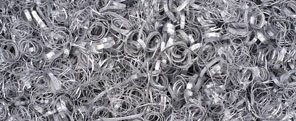|
Chips Off the Old Block
Every machinist is familiar with the creation of metal chips -- the shavings, filings, turnings and dust created by machining processes. This material can be stored for recycling, but cutting fluids and tramp oils on the chips often pose an environmental problem. When this is the case, oils are removed from chips using a centrifuge that separates fluids from the metal.
Chips present a safety problem to those around them and those who handle them. Chips can be very sharp and cause serious sudden or, such as in the case of persistent airborne particles, chronic injury. Virtually all machine shops discourage the handling of swarf with bare hands, although these rules are often ignored because they are considered impractical. The manual handling of chips, necessary, should be done with thick gloves that go above the wrist. Some operations have automated chip handling systems that remove and process chips for recycling. These systems require a high initial investment, but help minimize some of the safety issues involved with handling chips.
There are many different types of machine shavings. The type of metal being machined typically determines the type of chips it forms. Hard, brittle metals don't have high strength, so chips come off as small discontinuous bits. Materials that are softer or of higher strength may peel off in ribbons. Chip formation can also be important as a diagnostic tool, and is used by manufacturers to study the effectiveness of machining processes.
Machining operations store their chips for eventual processing by a metal scrap recycler. Most recyclers require the machine shop to drain fluids from the chips, and segregate them by metal (aluminum from steel, for example) but not by alloy grade.
Smoking Chips
Metals oxidize in the presence of water and air. Oxidation, (in metallic context also called corrosion) is an exothermic process. For machine chips stored in a pile or bin awaiting recycling, heat from oxidation can actually fuse the chips together. Heat from oxidation can accelerate this process and cause the chips to smoke. For some metals, such as magnesium, the generation of heat presents an extremely dangerous fire hazard.
Almost all metals oxidize, some more easily than others. Iron and steel oxidation shows up as rust, which is sometimes desirable as a protective coating on a steel surface, but not on a pile of chips. Also, the chips generated from cast metal have more porosity and offer more rapid oxidation because of the greater percentage of surface area exposed to oxygen. Finally, when chips of different metals are mixed together, galvanic corrosion may occur and compound the problem.
Preventing Smoke
The use of proper metalworking fluids can help prevent smoking chips. Soluble cutting oils (semi-synthetics, for example), leave a protective coating on chips. The addition of rust inhibitors in many cutting oils helps form a fine coating on the chips that will minimize oxidation.
Draining excess cutting oil from chips and drying them helps remove water, one of the primary ingredients for corrosion.
Large piles of chips left and forgotten for long periods are the most hazardous. Larger piles generate more heat than smaller ones, which may accelerate the oxidation process until it gets out of hand. The higher the oxidation rate of a pile of chips, the more heat that is generated and the greater the risk. Hot metal oxidizes faster than cool metal, so avoid storing chips in direct sunlight. Finally, be careful about storing chips near other flammable objects such as paper, wood or flammable chemicals.
Let Acculube Help You Kick the Habit
For expert advice on preventing smoking chips, and other issues related to machining, contact Acculube. Our technicians can help you minimize the risks of smoking chips and other hazards, and resolve issues related to coolant selection, tool performance, and environmental management as well.
NEXT ESSAY
 |
|
Talk with Us Today
Call the metalworking experts at Acculube - we'll help you get the most value
from every lubricant and other critical fluid you buy, and avoid the common pitfalls that can cost you money.
Contact Us: 1.800.404.2570 or email us at sales@acculube.com
|
|


